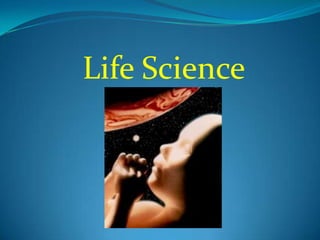
Apoyo biologia
- 1. LifeScience
- 2. Characteristics of living things Living things are organized All living creatures can be organized in hierarchy levels. Also living organisms are made of cells, the smallest unit of life. Living things acquire materials and energy Living organisms need to consume gather and consume energy. While autotrophs can make their own food, heterotrophs need to capture and consume other organisms to get their energy. Living things respond to their environment Organisms need to react to stimulus in their environment to ensure their survival. Living things reproduce Living creatures need to reproduce to pass down their DNA, while some organisms reproduce sexually, other can reproduce by themselves (asexually). Living things have the ability to adapt Living organisms need modifications to survive in their environment. The individual with better adaptations has more chances to survive and reproduce.
- 3. Classification of Living Things Systematics is the discipline of identifying and classifying organisms according to some criteria. Each organism needs to be placed in a species, genus, family, order, class, phylum, kingdom, and domain. From general to particular Taxonomy is the assignment of a binomial name to a specie. The first part of the name is the genus to which the specie belongs, and the second part is the species name.
- 4. Homeostasis All living organisms need to maintain an internal equilibrium in their bodies for their survival. Homeostasis is the maintenance of normal conditions inside an organisms achieved by the control of various physiological processes. If internal conditions were to changed drastically, diseases may occur.
- 5. CellTheory Basic principle of biology created by Theodor Schwann and Rudolph Virchow. The theory states that: The cell is the basic unit of life All living things are composed of cells Cell arise from pre-existing cells. The modern version states that: energy flow occurs in cells, DNA and genes are passed from cell to cell, and all cells have same basic chemical composition.
- 6. Theory of Evolutionby Natural Selection Theory proposed by Charles Darwin. The theory states that: Species change depending on time and place All life forms share a common ancestor Evolutionary change is slow Darwin proposed that natural selection determines the course of a specie. Survival of the fittest: Organisms better adapted to their environment have more chance to survive and pass their genes onto the next generation.
- 7. Origin of LifeTheory (Oparin-Haldane) Theory created by AleksandrOparin and J.B.S. Haldane. Theory that proposes that early eukaryotes (first unicellular organisms) emerged form nonliving matter through a process of million of years. According to both the Earth’s primitive atmosphere was filled with hydrogen, carbon dioxide, ammonia, and water vapor. While Oparin proposes that methane is the source of carbon life, Haldane thanks that carbon dioxide is the main source.
- 8. MalthusTheory of Population Theory proposed by Thomas Robert Malthus in his famous An Essay on the Principles of Population. The theory proposes that as long as human population increases in geometric proportions, food will also increase only in arithmetic proportions. Malthus said that if population increased uncontrollably then food will grow scarce and famine and diseases will arise.
- 9. Biodiversity Biodiversity is the total number of species, the variability of their genes, and the communities in which they live. Conservation of a great biodiversity is important to preserve species, ecosystems, and our existence. Present biodiversity is estimated as 5-30 million species, of which fewer than 2 million are identified and named.
- 10. Biome Biome is one of the biosphere’s major communities, characterized by climatic conditions and type of plants. Biome climate is mostly decided by latitude and altitude. Some biomes are tundra, taiga, temperate forest, tropical forest, shrublands, grasslands, and deserts. Biomes can house many large ecosystems of animals and plants.
- 11. Ecosystem Ecosystem is a biological community together with the associated abiotic environment; characterized by energy flow and energy recycling. In this specific area all aspects of the environment interact and affect each other. Disappearance of a specie, human intervention, or pollution may destroy the balance in an ecosystem
- 13. Chains usually start with human plant-life, continue with herbivores, and finish with carnivores (sometimes scavengers are included in food chains).
- 15. Their goal is to show all possible prey-predator relationshps in a defined ecosystem.
- 16. Food webs demostrate that when there are more predators than preys, the predators’ population tends to decrease.
- 18. Trophic levels show how energy flows in a single path.
- 19. Autotrophs (plants and trees) in the lowest level of the trophic levels are called primary producers.
- 20. The herbivores that consume plants are called primary consumers.
- 21. Carnivores that eat herbivores are called secondary consumers.
- 22. Carnivores that feed on other carnivores are called tertiary consumers.
- 23. Energy is partially lost as its flows from one level to the next one, so each level receives less energy than the one before it.
- 28. Some causes of greenhouse gasses’ accumulation are excessive burning of fossil fuels, clearing of forest, and other human activities.
